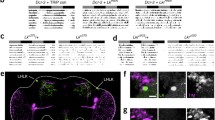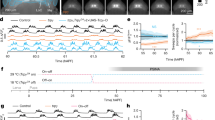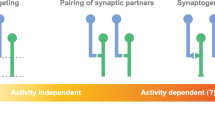Abstract
Circadian rhythms in the morphology of neurons have been demonstrated in the fly Drosophila melanogaster. One such rhythm is characterized by changes in the size of synaptic boutons of an identified flight motor neuron, with larger boutons during the day compared with those at night. A more detailed temporal resolution of this rhythm shows here that boutons grow at a time of increased locomotor activity during the morning but become gradually smaller during the day and second period of increased locomotor activity in the evening. We have experimentally manipulated the synaptic activity of the fly during short periods of the day to investigate whether changes in bouton size might be a consequence of the different levels of synaptic activity associated with the locomotion rhythm of the fly. In the late night and early morning, when the flies normally have an intense period of locomotion, the boutons grow independently of whether the flies are active or completely paralyzed. Bouton size is not affected by sleep-deprivation during the early night. The cycle in bouton size persists for 2 days even in decapitated flies, which do not move, reinforcing the notion that it is largely independent of synaptic activity, and showing that a pacemaker other than the main biological clock can drive it.



Similar content being viewed by others
References
Beramendi A, Peron S, Casanova G, Reggiani C, Cantera R (2007) The neuromuscular junction in abdominal muscles of Drosophila melanogaster during adulthood and aging. J Comp Neurol 501:498–508
Brand AH, Dormand EL (1995) The GAL4 system as a tool for unravelling the mysteries of the Drosophila nervous system. Curr Opin Neurobiol 5:572–578
Brand AH, Perrimon N (1993) Targeted gene expression as a means of altering cell fates and generating dominant phenotypes. Development 118:401–415
Cao G, Nitabach MN (2008) Circadian control of membrane excitability in Drosophila melanogaster lateral ventral clock neurons. J Neurosci 28:6493–6501
Chen ML, Green D, Liu L, Lam YC, Mukai L, Rao S, Ramagiri S, Krishnan KS, Engel JE, Lin JJ, Wu CF (2002) Unique biochemical and behavioral alterations in Drosophila shibire(ts1) mutants imply a conformational state affecting dynamin subcellular distribution and synaptic vesicle cycling. J Neurobiol 53:319–329
Consoulas C, Duch C, Bayline RJ, Levine RB (2000) Behavioral transformations during metamorphosis: remodeling of neural and motor systems. Brain Res 53:571–583
Consoulas C, Restifo LL, Levine RB (2002) Dendritic remodeling and growth of motorneurons during metamorphosis of Drosophila melanogaster. J Neurosci 22:4906–4917
Fernandes J, Keshishian H (1995) Neuromuscular development in Drosophila: insights from embryos and pupae. Curr Opin Neurobiol 5:10–18
Fernández MP, Berni J, Ceriani MF (2008) Circadian remodeling of neuronal circuits involved in rhythmic behavior. PLoS Biol 6:e69
Giebultowicz JM (2001) Peripheral clocks and their role in circadian timing: insights from insects. Philos Trans R Soc Lond Biol 356:1791–1799
Grima B, Chélot E, Xia R, Rouyer F (2004) Morning and evening peaks of activity rely on different clock neurons of the Drosophila brain. Nature 431:869–873
Hamasaka Y, Rieger D, Parmentier ML, Grau Y, Helfrich-Förster C, Nässel DR (2007) Glutamate and its metabotropic receptor in Drosophila clock neuron circuits. J Comp Neurol 505:32–45
Hamblen-Coyle MJ, Wheeler DA, Rutila JE, Rosbash M, Hall JC (1992) Behavior of period-altered circadian rhythm mutants of Drosophila in light:dark cycles (Diptera: Drosophilidae). J Insect Behav 5:417–446
Hardin PE (2005) The circadian timekeeping system of Drosophila. Curr Biol 15:R714–R722
Hebbar S, Fernandes JJ (2004) Pruning of motor neuron branches establishes the DLM innervation pattern in Drosophila. J Neurobiol 60:499–516
Hege DM, Stanewsky R, Hall JC, Giebultowicz JM (1997) Rhythmic expression of a PER-reporter in the Malpighian tubules of decapitated Drosophila: evidence for a brain-independent circadian clock. J Biol Rhythms 12:300–308
Helfrich-Förster C (1998) Robust circadian rhythmicity of Drosophila melanogaster requires the presence of lateral neurons: a brain-behavioral study of disconnected mutants. J Comp Physiol [A] 182:435–453
Helfrich-Förster C (2000) Differential control of morning and evening components in the activity rhythm of Drosophila melanogaster - sex-specific differences suggest a different quality of activity. J Biol Rhythms 15:135–154
Helfrich-Förster C (2005) Neurobiology of the fruit fly’s circadian clock. Genes Brain Behav 4:65–76
Hirsh J (1998) Decapitated Drosophila: a novel system for the study of biogenic amines. Adv Pharmacol 42:945–948
Jan LY, Jan YN (1982) Antibodies to horseradish peroxidase as specific neuronal markers in Drosophila and in grasshopper embryos. Proc Natl Acad Sci USA 79:2700–2704
Johansen J, Halpern ME, Keshishian H (1989) Axonal guidance and the development of muscle fiber-specific innervation in Drosophila embryos. J Neurosci 9:4318–4332
Keshishian H, Chiba A (1993) Neuromuscular development in Drosophila: insights from single neurons and single genes. Trends Neurosci 16:278–283
Kitamoto T (2001) Conditional modification of behavior in Drosophila by targeted expression of a temperature-sensitive shibire allele in defined neurons. J Neurobiol 47:81–92
Konopka RJ, Benzer S (1971) Clock mutants of Drosophila melanogaster. Proc Natl Acad Sci USA 68:2112–2116
Mahr A, Aberle H (2006) The expression pattern of Drosophila vesicular glutamate transporter: a marker protein for motorneurons and glutamatergic centers in the brain. Gene Expr Patterns 6:299–309
Martinez VG, Javadi CS, Ngo E, Ngo L, Lagow RD, Zhang B (2007) Age-related changes in climbing behavior and neural circuit physiology in Drosophila. Dev Neurobiol 67:778-791
Masur SK, Kim YT, Wu CF (1990) Reversible inhibition of endocytosis in cultured neurons from the Drosophila temperature-sensitive mutant shibire ts1. J Neurogenet 6:191–206
Mehnert KI, Beramendi A, Elghazali F, Negro P, Kyriacou CP, Cantera R (2007) Circadian changes in Drosophila motor terminals. Dev Neurobiol 67:415–421
Meinertzhagen IA, Pyza E (1996) Daily rhythms in cells of the fly’s optic lobe: taking time out from the circadian clock. Trends Neurosci 19:285–291
Panda S, Hogenesch JB, Kay SA (2002) Circadian rhythms from flies to human. Nature 417:329–335
Park JH, Helfrich-Förster C, Lee G, Lui L, Rosbash M, Hall JC (2000) Differential regulation of circadian pacemaker output by separate clock genes in Drosophila. Proc Natl Acad Sci USA 97:3608–3613
Pyza E, Gorska-Andrzejak J (2004) Involvement of glial cells in rhythmic size changes in neurons of the house-fly’s visual system. J Neurobiol 59:205–215
Pyza E, Meinertzhagen IA (1999) Daily rhythmic changes of cell size and shape in the first optic neuropil in Drosophila melanogaster. J Neurobiol 40:77–88
Rivlin PK, Clair RST, Vilinsky I, Deitcher DL (2004) Morphology and molecular organization of the adult neuromuscular junction of Drosophila. J Comp Neurol 468:596–613
Sehgal A, Price JL, Man B, Young MW (1994) Loss of circadian behavioral rhythms and per RNA oscillations in the Drosophila mutant timeless. Science 263:1603–1606
Shaw PJ, Cirelli C, Greenspan RJ, Tononi G (2000) Correlates of sleep and waking in Drosophila melanogaster. Science 287:1834–1837
Shaw PJ, Tononi G, Greenspan RJ, Robinson DF (2002) Stress response genes protect against lethal effects of sleep deprivation in Drosophila. Nature 16:287–291
Stoleru D, Peng Y, Agosto J, Rosbash M (2004) Coupled oscillators control morning and evening locomotor behaviour of Drosophila. Nature 431:862–868
Taghert PH, Shafer OT (2006) Mechanisms of clock output in the Drosophila circadian pacemaker system. J Biol Rhythms 21:445–457
Truman JW (1990) Metamorphosis of the central nervous system of Drosophila. J Neurobiol 21:1072–1084
Wheeler DA, Hamblen-Coyle MJ, Dushay MS, Hall JC (1993) Behavior in light-dark cycles of Drosophila mutants that are arrhythmic, blind, or both. J Biol Rhythms 8:67–94
Williams JA, Sehgal A (2001) Molecular components of the circadian system in Drosophila. Annu Rev Physiol 63:729–755
Yellman C, Tao H, He B, Hirsh J (1997) Conserved and sexually dimorphic behavioral responses to biogenic amines in decapitated Drosophila. Proc Natl Acad Sci USA 94:4131–4136
Acknowledgements
The authors thank H. Aberle (Tübingen) for the OK371-GAL4 stock, T. Kitamoto (Iowa) for the UAS-shi ts1 stock, C. Kyriacou (Leicester) and H. Dircksen (Stockholm) for valuable suggestions during the preparation of the manuscript.
Author information
Authors and Affiliations
Corresponding author
Additional information
This project was supported by a grant from the Swedish Research Council.
Rights and permissions
About this article
Cite this article
Mehnert, K.I., Cantera, R. A peripheral pacemaker drives the circadian rhythm of synaptic boutons in Drosophila independently of synaptic activity. Cell Tissue Res 334, 103–109 (2008). https://doi.org/10.1007/s00441-008-0670-0
Received:
Accepted:
Published:
Issue Date:
DOI: https://doi.org/10.1007/s00441-008-0670-0




